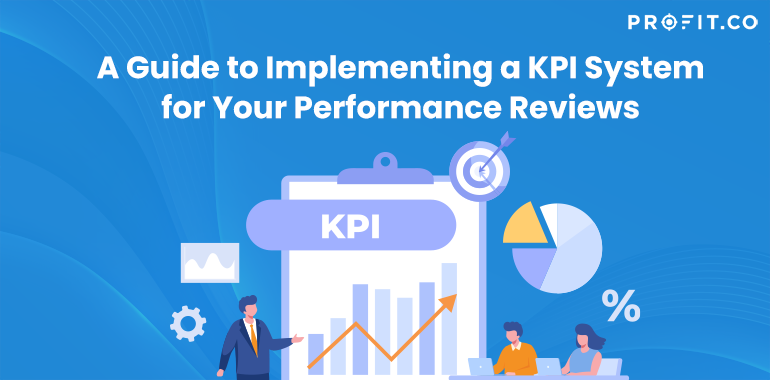As managers, you are tasked with ensuring that your employees are performing well. In turn, you are also responsible for reporting your team’s progress to your superiors at regular intervals. The best way to do that is to have easily interpretable data that gives clarity as to how much progress your employees are making toward their objectives. Simply put, Key Performance Indicators, or KPIs, are the answer. However, every business has its own way of doing things, and that can make implementing new systems complicated and expensive if done poorly. We are going to discuss some key ideas to remember when you decide to implement your own KPI system to conduct employee performance reviews.
What are Performance Reviews?
Performance reviews, also known as employee appraisals or performance evaluations, are essential for assessing employee performance against set goals. These reviews provide insights into an employee’s strengths, areas for improvement, and suitability for new roles. Typically managed by the HR department within a budget, performance reviews are crucial for determining pay raises and bonuses, fostering better manager-team dynamics, and enhancing overall workflow.
What are KPIs?
KPIs are measurable indicators that can quantify a company’s long-term progress. They can be essential in planning strategy, finances, and operations while giving you a benchmark for your industry’s standards. By collating several relevant KPIs, you can have a simple way of tracking your team’s progress towards any objective. They are divided into three categories:
- Strategic KPIs: For the business executives, it gives an overview of how the company is doing
- Operational KPIs: Measured over a smaller time frame, these KPIs measure the performance of specific business sections on a month-to-month basis
- Functional KPI: measures the performance of specific departments or sections like the finance or marketing departments
There are a variety of KPIs for many different functions. While setting up your KPI reporting system, you must choose only what is relevant and not include as many as possible for the sake of it. These metrics can be useful to the employees they are measuring, and you do not want them focusing on metrics that misguide them.
What gets measured gets improved.
Understanding KPIs in the Context of Performance Reviews
KPIs replace ambiguity with clarity in performance reviews. They offer a clear, unbiased way to assess employee performance, aligning individual achievements with business growth. For example, when XYZ Corp. implemented KPIs, they saw a 25% increase in employee productivity within a year.
Ready to explore how Profit.co can simplify your work?
Applying KPIs
While we have discussed the various benefits of using KPIs in your organization, it should be stated that they cannot be used alone. A misconception is that KPIs can be the final metric for evaluating employee performance. However, as any experienced manager can tell you, they are merely a tool to use in conjunction with your judgement. Numbers only present one side of the situation, and the best people to evaluate your employees are intimately familiar with the work and industry within which they operate. This is why you will find many performance evaluation methods that uniquely approach different company cultures.
Implementing a KPI System in Performance Reviews
Creating a KPI System
That said, we can still highlight some key practices you could follow when deciding how to implement a KPI system in your performance evaluation. To ensure it runs smoothly alongside your existing systems, you should work with the employees who conduct the performance evaluations for their input.
Identifying the right KPIs
Choosing the right Key Performance Indicators (KPIs) is a crucial first step. These metrics should be both relevant and measurable. For instance, a marketing team member might have KPIs tied to the return on investment (ROI) of marketing campaigns. Meanwhile, a project manager could focus on KPIs related to project delivery timelines. It’s like setting specific targets in a game; each player (employee) has their own goalpost, depending on their role.
Aligning KPIs with organizational objectives
Your KPIs should directly support your company’s broader goals. If a key objective is enhancing customer satisfaction, KPIs might include customer feedback scores or issue resolution times. This approach ensures that every individual’s efforts contribute to the collective goal. For example, XYZ Corporation focused on customer retention as a primary objective, and by aligning their KPIs accordingly, they saw a significant increase in customer loyalty.

Integrating KPIs into performance reviews
Integrating KPIs into performance reviews transforms the evaluation process into a data-driven, objective exercise, directly linking individual performance to organizational goals. This integration clarifies expectations for employees and provides a clear framework for assessing and discussing their contributions and growth areas.
Communicating KPIs to employees
Clarity and transparency are essential when introducing KPIs to your team. Clearly explain how each KPI is linked to broader company objectives. Take ABC Ltd. as an example: employees reported feeling more engaged and purposeful when, due to proper communication of their KPIs, they understood how their individual roles played into the bigger picture.
Training managers and employees
Investing in comprehensive training sessions helps staff to understand and utilize KPIs effectively. Continuous education is crucial, especially as business needs evolve. Regular workshops or training modules keep everyone up-to-date and proficient in working with these metrics.
Monitoring and adjusting KPIs
Monitoring and adjusting KPIs is a crucial ongoing process that ensures your performance metrics remain relevant, challenging, and aligned with evolving business objectives. Regularly reviewing and fine-tuning KPIs based on performance data and business changes ensures that your appraisal system accurately reflects current priorities and employee achievements.
Regularly reviewing KPI effectiveness
Establish a routine schedule for reviewing the effectiveness of your KPIs. Just like a coach reviews game tapes to improve strategies, regularly assess your KPIs to ensure they remain relevant and continue to challenge your team effectively.
Adapting KPIs to changing business needs
Flexibility is key. As your business environment and objectives evolve, so should your KPIs. For instance, a tech company in its nascent stages might initially focus on product development KPIs. Still, as it transitions into a growth phase, the focus might shift toward market penetration and customer acquisition.
When applying KPIs, it’s important to:
- Determine the specific business area for KPI implementation and understand its nuances
- Research industry benchmarks to set realistic and motivating targets
- Compare new KPIs with existing goals to ensure alignment and relevance
- Communicate expectations clearly across all levels of the organization, welcoming feedback
- Monitor performance changes post-implementation to gauge the impact of your KPI system
- Schedule regular reviews of KPI progress, making adjustments or overhauls as necessary
In this dynamic environment, Profit.co’s OKRs and KPI tools can be particularly valuable. They offer a comprehensive platform that aligns KPIs with your organization’s objectives and key results. Profit.co’s system enables real-time tracking and monitoring of KPIs, ensuring they remain relevant and effective in line with your evolving business needs. With features that support clear communication and regular updates, Profit.co makes it easier to stay on top of your KPI adjustments, facilitating a seamless transition as your business grows and changes.
Download our comprehensive guide for implementing a Key Performance Indicator (KPI) system in your performance reviews. This template provides a clear and actionable roadmap to help you seamlessly integrate KPIs into your organization’s performance evaluation process.
Conclusion
Creating an effective performance management system, which includes a robust Key Performance Indicator (KPI) framework, requires thoughtful consideration of your employees’ work styles and the unique needs of your organization. Leveraging digital tools can significantly streamline this process. Software solutions can facilitate easy access for all team members and automate repetitive tasks, making the implementation of your KPI system more efficient and less time-consuming. By focusing on these aspects, you can develop a KPI system that not only measures performance effectively but also aligns seamlessly with your team’s workflow and organizational objectives.

